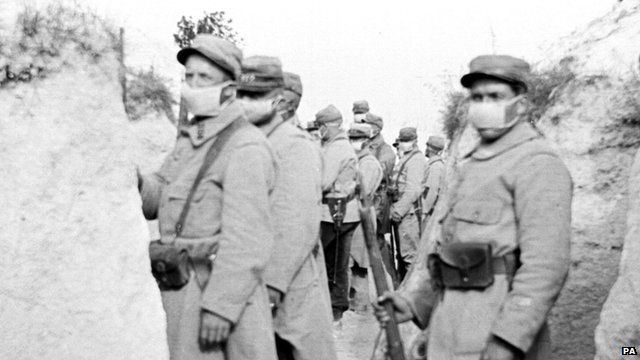World War One: Scientist John Haldane tested gas on himself
- Published

Scientist John Haldane developed the veil respirator, but troops said it left them unable to breathe
When the Germans launched the first gas attacks in 1915, the allies were desperate to find out what chemicals were used and how they could protect troops in the front line. The War Office called in an Oxford academic to help - a man who was prepared to put his own life at risk to produce the first gas mask.
Not many of today's scientists would be prepared, let alone permitted, to test dangerous gases on themselves at home, relying on their teenage daughter to break in and revive them if they passed out from the effects.
But, John Scott Haldane was anything but orthodox, according to Dr Steve Sturdy from the University of Edinburgh.
"Haldane was a great self-experimenter - he thought the human organism was the best animal to experiment on because it could report on what it was experiencing."
Lord Kitchener himself called on Mr Haldane for help, after the Germans released clouds of chlorine gas across the front line around the Belgian city of Ypres, on 22 April 1915.
Urine-soaked socks
In an Imperial War Museum podcast, external, Bert Newman of the Royal Army Medical Corps describes seeing the effects on Canadian troops of a second gas attack two days later.
Soldiers had been told to improvise primitive protection, including soaking socks in their own urine and tying them around their faces.
"[But] in the end, you could see all these poor chaps laying on the Menin Road, gasping for breath," Mr Newman recalled.
"And the thing was it was no gas masks then, you see, and a lot of these chaps just had to wet their handkerchiefs and put it over their mouth or do what they could."
By 1916, the gas masks available had become more effective and easier to use
Mr Haldane already had a wealth of experience in working with dangerous gases from his pre-war work in the mining industry.
"He'd been visiting collieries after coal mine explosions and other disasters, determining the cause of death, much of which was due to poison gases that were present in the mine," according to Dr Sturdy.
"He'd also been involved in breathing apparatus that could be used in mines after explosions."
After the Ypres attacks, Mr Haldane and a colleague were rushed to Belgium, to find out what gas the Germans were using.
They identified chlorine from the way it had discoloured brass buttons on dead soldiers' uniforms.
Daughter stationed outside
Back at his home laboratory, Mr Haldane set about looking for a quick counter measure troops could be given, unconcerned about the effects it would have on him.
"He'd always experimented on himself and so in the urgency of warfare, and the fact that these were gases that were being used for deliberately harmful purposes, he did end up exposing himself to far more harmful levels of gas than he would have done in peacetime," said Dr Sturdy.
"Naomi [his eighteen-year-old daughter] was stationed outside the door, which had a window in it, with instructions that if he were incapacitated she should get him out as soon as possible."
Mr Haldane's quick fix was a small step forward from the wet handkerchiefs and urine-soaked socks.
"They were called veil respirators, and it was basically pads of cotton waste that were wrapped in gauze soaked in a solution of sodium thiosulphate, which neutralised the effects of low concentrations of chlorine gas," Dr Sturdy explained.
"These could be bound over the face, nose and mouth [but] he recognised that these were very much a stop gap."
The box respirator became the design of choice, but it was not available until 1917
Stretcher bearer William Collins, in another Imperial War Museum podcast, external, described how he was one of the first to use a veil respirator.
"About midday that day, supplies of the first so-called gas masks came up, and all it consisted of was a pad of wool covered by gauze with an elastic band running right round and about four inches by two.
"But, I found using it in the gas cloud that after a couple of minutes one couldn't breathe and so it was pushed up over the forehead and we swallowed the gas.
"It was not a practical proposition at all."
Mr Haldane went on to help with the development of the much more effective box respirators, which were used during the rest of the war.
Anti-German feeling
However, the Edinburgh-born academic and fellow of New College Oxford could have found reasons not to help the British war effort at all.
His brother Richard, who was Secretary of State for War and then Lord Chancellor, suffered from the wave of anti-German feeling that swept the country at the start of World War One.
"[Some] newspapers launched attacks on him because he'd studied in Germany, he spoke very good German and had close relations with German colleagues," according to Dr Sturdy.
"He was hounded out of office, and I think John Haldane suffered from that as well."
But, Mr Haldane continued his work throughout the war, and continued to experiment on himself.
He also used his son, who was in his 20s, in some experiments - it seemed to do him no harm, nor did it put him off science, as he went on to become a professor of genetics.
Hear about the dangers of researching poison gas and find out more from Dr Sam Willis on how colourful camouflage could dazzle at sea.